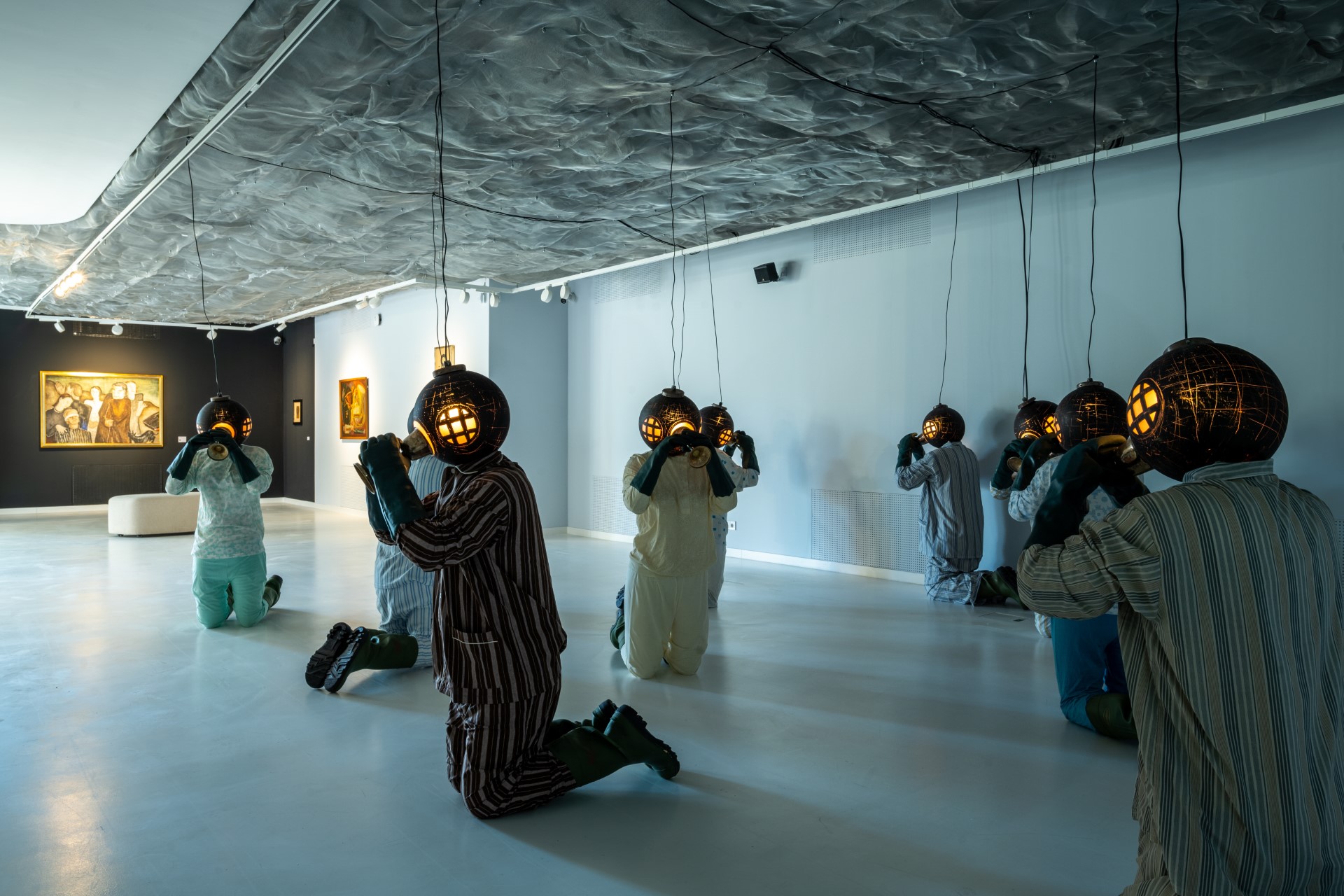Discover Symbolist and Poet Gyula Tichy at the Hungarian National Gallery

Melancholy, c. 1912, blue linocut on paper, from the Museum of Fine Arts – Hungarian National Gallery, Budapest.
The exhibition of work by Hungarian painter-poet Gyula Tichy at the Hungarian National Gallery (MNG) in Budapest, entitled “The Master of Hungarian Symbolism,” is a revelation, writes David Holzer.
Knowing nothing about Hungarian symbolism, I have no idea whether Tichy is its master. But there’s something about his paintings, graphic art, and drawings that’s unlike anything I’ve ever seen.
Gyula Tichy was born in what was then called Rimaszombat (now Rimasvská Sobota in modern-day Slovakia) in 1878 and died in 1920. After high school, he began training as a mechanical engineer but dropped out for health reasons and transferred to the Model Drawing School in Budapest.
After he graduated, Tichy taught art at the painting school in Nagybánya (then in what was eastern Hungary, but now known as Baia Mare and in Romania) and at high schools in Fasor (Budapest) and Rozsnyó (now Slovakia).
He was a member of Kéve, the Association of Hungarian Fine and Applied Artists founded in 1907, which united styles such as Art Nouveau, naturalism, post-impressionism, and Fauvism to promote its members’ work, and was a regular contributor at its exhibitions.
Like Kéve itself, Tichy’s work was heavily influenced by Art Nouveau, particularly that of British graphic artist Aubrey Beardsley, who exhibited in Budapest. Tichy illustrated several books and published collections of his own work. The best known of these is 1909’s “Tales of an Ink Bottle.” He also published drawings in the Móka magazine.
From 1914, when he struggled with ill health, visual arts gradually receded into the background of Tichy’s life. Always interested in physics, astronomy, and the technological advances of his time, he focused on writing a science fiction novel, “Prisoners of Mars,” which he never finished. He was working on his memoir when he died at the young age of 31.
An Artist Rediscovered
During his lifetime, Tichy was reasonably successful, exhibiting in Vienna and Munich in 1914. Today, he is being rediscovered by art historians and the public. Curious about what makes Tichy’s work so unusual, I spoke to Eszter Földi, curator of the exhibition. She is now an art historian at the Moholy-Nagy University of Art and Design in Budapest, but at the time this exhibition was initially conceived, she was a senior curator at MNG.
Földi specializes in Hungarian art from the second half of the 19th century and the first third of the 20th.
In 2005, she was the curator of an exhibition of Hungarian woodcut and linocut art in Miskolc (180 km northeast of Budapest). Researching Hungarian art at the beginning of the 20th century and the symbolist and Art Nouveau period, she discovered Tichy’s work.
Symbolism was a late 19th-century movement in the arts that sought to represent absolute truths symbolically through images and language. Unlike naturalism and realism, symbolism was more about how what was depicted or described affected the viewer or listener. The imagery used by symbolist painters was often drawn from dreams and mythology. It was intensely personal and private, ambiguous and obscure.
“I found Tichy’s work to be highly original,” Földi tells me. “In him, I saw something special. He was influenced by Japanism, Vienna Art Nouveau, and so on, but he had a unique way of seeing that I liked very much,” she explains.
“I started with his linocuts and moved on to his work in other media. I also learned he was a writer. I was intrigued by the fact that Tichy was interested in areas such as mechanics, science, natural science, astrology, and science fiction, and this made his oeuvre more complex than that of other artists,” she argues.
This complexity is reflected in two works entitled “Melancholia,” one a linocut and the other an etching. Both feature an odd combination of classical and modern imagery that, apart from making general observations, I find impossible to decipher. This, along with Tichy’s technical skill, makes the work deeply compelling.
Most Comprehensive
The Tichy exhibition at the MNG consists of around 80 works and is the most comprehensive yet mounted. Thanks to a private collector offering pieces from his collection, it includes work that has rarely been seen before or is being exhibited for the first time.
“We had a large collection of linocuts at the MNG, but we didn’t have many China ink drawings or etchings,” Földi explains. “We’d known for a long time that this collector had a number of works that had been left by Tichy after his death, and we were really keen to have these in the exhibition.”
The collector donated China ink drawings, etchings, and the so-called “Prophesy cycle” made by Tichy in 1916, in the middle of World War I. This, Földi says, offers an insight into the artist’s thinking and depicts how nine prominent Hungarians could use technological innovations to help Hungary win the war.”
The response from the general public to the exhibition, which was originally intended to be mounted in 2020 (the 100th anniversary of Tichy’s death) but was delayed by the pandemic, has been uniformly positive.
“It’s been a revelation to the general public,” Földi says, “and to my colleagues.”
For me, the Gyula Tichy exhibition is yet another introduction to a fascinating Hungarian artist of whom I’d never heard. I asked Földi why she thought so many great Hungarian artists are simply unknown outside this country.
“The artists that are known abroad, Moholy-Nagy or Victor Vasarely, for example, lived and worked outside Hungary, in Europe and the United States. The work of those Hungarian artists who stayed at home is not represented in the big museum collections in other countries, so they don’t have any kind of reputation.”
All the more reason to keep an eye on what’s on show at excellent Budapest venues such as the Hungarian National Gallery.
“The Painter-Poet. Gyula Tichy, the Master of Hungarian Symbolism” is on at the Hungarian National Gallery in Budapest until March 5.
This article was first published in the Budapest Business Journal print issue of January 13, 2023.
SUPPORT THE BUDAPEST BUSINESS JOURNAL
Producing journalism that is worthy of the name is a costly business. For 27 years, the publishers, editors and reporters of the Budapest Business Journal have striven to bring you business news that works, information that you can trust, that is factual, accurate and presented without fear or favor.
Newspaper organizations across the globe have struggled to find a business model that allows them to continue to excel, without compromising their ability to perform. Most recently, some have experimented with the idea of involving their most important stakeholders, their readers.
We would like to offer that same opportunity to our readers. We would like to invite you to help us deliver the quality business journalism you require. Hit our Support the BBJ button and you can choose the how much and how often you send us your contributions.







